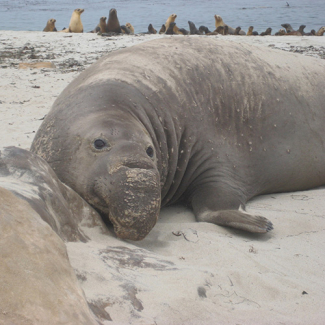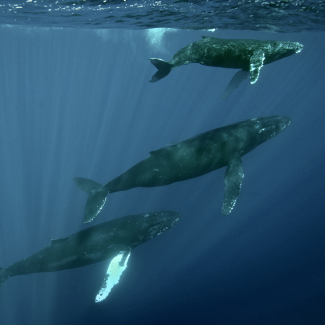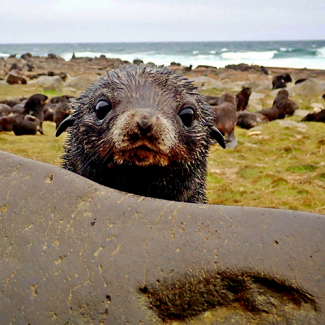What Kinds Of Animals Usually Live In The Areas Represented By Blue Shading On A Map
Marine mammals
Marine mammals are plant in marine ecosystems around the globe. They are a various group of mammals with unique physical adaptations that let them to thrive in the marine environment with extreme temperatures, depths, force per unit area, and darkness. Marine mammals are classified into four unlike taxonomic groups: cetaceans (whales, dolphins, and porpoises), pinnipeds (seals, sea lions, and walruses), sirenians (manatees and dugongs), and marine fissipeds (polar bears and bounding main otters).
What is a marine mammal?
What makes a marine mammal a marine mammal? They must meet the characteristics of all mammals — they breathe air through lungs, are warm-blooded, take pilus (at some indicate during life), and produce milk to nurse their immature — while also living virtually or all of their lives in or very near the ocean.

In late December 2015, Ed Lyman started getting calls from whale watching companies on the island of Hawai'i. "Ed, how are the whales off Maui?" bout operators were request. "We've never seen them arrive this late."
Marine mammal ecology
Marine mammals represent a variety of ecological roles, including herbivores (manatees), filter feeders (baleen whales), and top predators (killer whales). Mammals evolved on land around 160 million years ago. Each taxonomic marine mammal grouping evolved from a dissimilar group of land mammals, whose ancestors separately ventured back into the ocean environment. Despite these different origins, many marine mammals evolved similar features — streamlined bodies, paddle-like limbs and tails — through convergent development.

NOAA research helps identify differences in elephant seal feeding patterns
Types of marine mammals
Cetaceans offsite link (whales, porpoises, and dolphins) are categorized into two chief groups: baleen whales (mysticetes) and toothed whales (odontocetes). They spend their lives in water, and have many adaptations offsite link to their entirely aquatic lifestyle. At that place are over 70 different species of cetacean.
Pinnipeds offsite link are in the suborder pinnipedia, which ways "fin-footed." These carnivores use flippers to motility both on land and in the water. Pinnipeds spend the majority of their lives swimming and eating in water and come onto land or water ice floes to bear their young, residual, and molt.
Similar cetaceans, sirenians also spend their whole lives in water. They are the but entirely herbivorous group of marine mammals. Sirenians are named for sirens, the legendary Greek sea beauties who lured sailors into the sea. Some call back historic mermaid sightings were actually sirenians, not the mythical half women, one-half fish.
The marine fissipeds offsite link are considered marine mammals, but spend most of their time on land and just part of the time in the h2o, mainly to hunt for their nutrient.

"Sonobuoys" record sea sounds and are deployed over the side of a send to ship back real-time recordings.
Threats and protection
Threats to marine mammals are largely from human impacts, including accidental capture in fishing gear, habitat destruction, poaching, pollution, harassment, and ship strikes. All marine mammals in waters of the United States are protected nether the Marine Mammal Protection Deed (MMPA). NOAA Fisheries collaborates with several partners to protect these species. Anyone can assistance protect marine mammals by showing proper ocean etiquette. Adore them from a altitude; never bear on, feed, harm, or swim with a marine mammal.

A NOAA Fisheries partnership is developing imaging applied science for drones that could significantly reduce toll, take a chance, and disturbance in marine mammal surveys.
Didactics Connectedness
The pedagogy resource in this collection provide educators and students opportunities to explore the adaptations, population dynamics, environmental, threats, behaviors, and beefcake of marine mammals. This collection includes resources to help students better understand the biology of marine mammals likewise as their part in protecting these species.
Source: http://www.noaa.gov/education/resource-collections/marine-life/marine-mammals
Posted by: maysracion.blogspot.com

0 Response to "What Kinds Of Animals Usually Live In The Areas Represented By Blue Shading On A Map"
Post a Comment